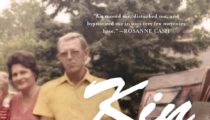It’s six a.m. on an April morning. I sit at…

This American Fife
The piano may do for love-sick girls who lace themselves to skeletons,
and lunch on chalk, pickles and slate pencils. But give me the banjo.
—Mark Twain
In 2007, bluegrass banjoist Eddie Adcock did an ordinary thing at an extraordinary time. Robbed of his ability to make music due to involuntary hand tremors, Adcock opted for a risky procedure in which surgeons would install a tiny electrode into the malfunctioning part of his brain. The catch was that to find the exact spot to stick it, Adcock would have to play his banjo while the doctors operated. Or, maybe, the doctors would play the banjo vis-a-vis Adcock’s brain. I guess it depends on your perspective.
In the video of the procedure, Adcock, sixties and white, sits with a plastic curtain around his head. A banjo, emblazoned with an American flag on its own head, is practically useless in his hands. Behind the curtain, the surgeons drill and poke and zap the back of his head. All at once, Adcock goes from fumbling to dexterous, mountain twang rolling from his fingers. They move the electrode and the music stops. They move it again. The music returns.
The story made global news; Barbara Walters even covered it. It’s easy to see why—an old white man, his loving wife, the feel-good convergence of culture and medicine. And then there’s that banjo, that flag. It’s hard to image the story being as quaint if he’d played a guitar.
Part of the charm, I think, is that the banjo doesn’t seem like the kind of instrument you’d risk your life over. Nat Winston, a psychiatrist and musician from Nashville, wrote that the banjo was “an extrovert of musical instruments, nothing to be thought about, and certainly nothing to be loved except with the rough-em-up form of affection you might bestow on a friendly pup.” Steve Martin said, “The banjo is such a happy instrument—you can’t play a sad song on the banjo—it always comes out so cheerful.” The most popular brand of banjo in America is appropriately named The Goodtime.
Maybe it’s the banjo’s appearance. Even the shape is comic: a drum on a stick. On a banjo, the drum is called the pot. The head of the pot is made of skin, stretched so tight that the banjo sings. Because the skin stretches with time and climate, a banjo is always subtly changing its tone. Some ancient banjo pots were made from gourds. Today’s are typically made of wood or metal. Occasionally, banjo pots are made from life’s trash: salad bowls, hatboxes, the torque converters from 1950s Buicks. Regardless, the skin is what makes a banjo a banjo.
Banjos weren’t mass-produced until after the American Civil War, but they quickly became America’s most popular instrument. Compared to violins and guitars, they were cheaper and easier to make and repair. Because of the simplicity, a banjo can be disassembled into its constituent parts.
Despite the simplicity, banjos are expressive in design. Some banjo builders inlay silver or goal purfling into the fingerboards. Others are inlaid with detailed abalone images of flowerpots, or sparrows, or creatures from the medieval bestiary. I once played a banjo with a dragon carved along the back of its neck. Another one I played was inlaid with pearlescent spaceships and satellites: the past and future in your hands.
I once played a banjo carved mostly with a pocketknife so that it looked like it was made by a person who only owned a pocketknife. The banjo’s owner was a forty-year-old man that I played music with for a few years. He lived with his wife in a tiny house on a long dirt road, past a Confederate cemetery in southern West Virginia. I would drive there in the summer to play fiddle tunes and drink beer on his porch. This was in 2014. They had an outhouse, thirty chickens, and a bellicose peacock. I’d just moved to West Virginia and I used a lot of thesaurus words, like pearlescent and bellicose.
Back then I was playing a Goodtime. Like most banjos, it had a fretted neck like a guitar, allowing the player to finger the same notes consistently. But some banjos—like my friend’s—have a smooth, unfretted neck like a violin. The earliest folk recordings feature fretless banjos.
Play a banjo without frets, and the notes slip and slur into one another. Fretless banjos aren’t constrained to the twelve-note system of Western musical thought. They contain microtones, the notes where the commas are. Some listeners have internalized the twelve-note system so deeply that they think microtones are just sour notes.
I didn’t believe in microtones at first because they weren’t discussed in the music books I’d read. But then I was told that I was constrained by the twelve-note system of Western musical thought. So I found a 1920s laminate banjo pot with an unfretted neck. I strung the banjo with nylon strings meant to simulate old-time gut strings. I wanted it to sound archaic; to re-create what one musician called “that old West Virginia graveyard music.”
Unlike the brassy, rollicking bluegrass music most people are familiar with, the songs my friend played were sad or ambivalent, using microtones to alternate between major and minor keys many times in the same song. He said the songs were sad because life in the mountains had been isolating. Midwestern folk music, he said, was happier and more upbeat because life there was more social. I fell in love with old-time banjo music for a while. The heavy syncopation, the ragged edges. The common joke is that old-time music is “so good, it sounds bad.”
Rural West Virginia was, in a lot of ways, like the tiny town I was from in Upper Pennsylvania—clannish, run-down, and charming. But unlike my part of Pennsylvania, in West Virginia the folk music traditions had been preserved. But it wasn’t the true past that people like me connected with. It was the heritage. You know, the part of history that assumes the past won’t be remembered on its own, so it makes something so remarkable that we have to keep it. But heritage is also stripped of its contexts and missteps, history’s highlight reel. While I didn’t see it at the time, I loved that old Appalachian mountain sound because everyone said it was white and rural and lost, which was how I saw myself.
■■■
There are many ways to play a banjo. Ragtime and blues players liked to thwap their banjos with plectrums, choking the strings to limit reverberation. Irish musicians like to note fast, articulate melodies in unison with a fiddle or fife. Bluegrass players roll their fingers over the strings in syncopated patterns of three and four, tickling the strings.
Most tradition Appalachian musicians play with a highly specific style called clawhammer, in which the index finger flicks single notes while the thumb and remaining fingers play drones and shifting chords. With clawhammer style you can play the rhythm and melody. You are you own accompaniment—perfect for an isolated place.
To understand clawhammer’s rhythm, read this out loud:
Claw hammer. Claw hammer.
Or:
1 ( ) 3 4 5 ( ) 7 8.
Or:
Bum ditty. Bum ditty.
I started playing clawhammer banjo in college. There’d been some seniors on campus my freshman year. They played old-time country music and were radical environmentalists— almost as hillbilly as hippie. It was my first time seeing those two things together. Most of my old hometown friends had become loggers, and these kids were more likely to chain themselves to construction equipment. Some of them, it turned out, were rich kids. But that was okay. They represented a convergence of the things I’d been and things I wanted to be. And the banjo symbolized it perfectly.
I bought my Goodtime and learned the clawhammer style from a Smithsonian documentary featuring clips of Black migrant farmers and poor white southerners playing their songs for an ethnographer’s lens. I remember that documentary clearly. I watched it in my sterile cinderblock dorm room in the spring of 2007, wearing my father’s flannel shirt. My hair was long and I’d just stuck a sticker on my banjo case actually, literally said “This Machine Kills Fascists.” On the screen men sang about their troubles: crop damage, heartache, addiction, poverty, loss. My family had real troubles, too. Lives as similar to the singers as they were to mine. My father had sold timber from our property to buy my textbooks; our hometown was puckering like an old apple; my sister’s husband was a mean drunk. But I didn’t think of those things back then. I was too busy toting around the banjo, sitting in the grass of the campus quad, sandals strewn beside me, practicing those first few songs while people walked by and asked: is that a banjo?
Yeah, I told them. This was cultural preservation, an act of defiance against modern commodification of music. I was getting in touch with my roots.
And in a way, I was. The word banjo may be portmanteau of banza (an African instrument) and the Caribbean verb banja—meaning to play the fool.
■■■
There are few images as closely tied with white rural life as the banjo. Think Deliverance. Think Beverly Hillbillies. Think Little House on the Prairie. But the banjo’s origins are syncretic. The banjo, or its predecessors, arrived in North America via the West African slave trade. Early American records brim with accounts of slaves playing the banjo. An enslaved person’s musical skills were often mentioned when they were bought and sold. In the Caribbean, enslaved people were disallowed from playing drums (drums could be used to signal revolts) so slaves stuck to banjos and flutes, sometimes adopting European fifes.
The banjo was associated with Black people for most of what we call American History. It’s only for the last 120 years or so that the banjo has been thought of as a white, rural instrument. But even when whites weren’t playing the thing, we were its arbiters. One eighteenth-century musician, a freed Black man named Banjo Billy, was remembered by an admirer in the New York Times as “a famous banjo player. And not the fanciful instruments of today, handled by cork-faced counterfeits, but the genuine banjo of the Negro.” Then, like now, the gates to authenticity were closely guarded.
White people probably first started playing the banjo on plantations, but “the cork-faced counterfeits” of minstrel shows were likely the first white people to perform with a banjo. Covered in blackface (often made from charred cork) white minstrels sang songs like “Darkie’s Delight,” “The Free N——r,” and “Genuine Negro Jig.” One of the primary themes of minstrel shows—like today’s country music—was nostalgia. Minstrels were targeting white audiences who wanted to remember slavery as a happy and carefree existence for Black Americans. Even in its heyday, the banjo was concerned with the past.
The supposed progenitor of the minstrel show, a military fife player from Ohio named Dan Emmett, put together
his first band, “The Virginia Minstrels” in New York City in the 1840s. Best known for writing “Dixie,” which became a rallying cry for the Confederacy, Emmett learned much of his repertoire from a white West Virginia man named Archibald Ferguson. (At the time, West Virginia was still a part of Virginia.) Emmett hired Ferguson to work with his traveling show and, as soon as he’d learned all of Ferguson’s techniques and tunes, Emmett fired him, writing that Ferguson was “very ignorant and n——r all over, except in color.”
The mimesis gets even more fucked up from there. After emancipation, it was common for African-American musicians to enter minstrelsy because it paid much better than performing for Black audiences. These performers typically wore blackface and white gloves so they would pass as white men trying to look like Black men, not Black men trying to look like white men trying to look like Black men. Men also performed as women. One of the first
female impersonators, George Christy, was famous for his performance of a mixed-race seductress named Lucy Long. While cavorting around the stage, he’d narrate Lucy’s pursuit of men from multiple points of view, singing, “If she becomes a scolding wife / as surely she was born / I’ll take her down to Georgia / and trade her off for corn.”
■■■
In the old-time music community, it’s common to hear that “the banjo came from Africa,” which is a subtle whitewash, winking at the past without ever having to look hard at it. It’s more accurate to say that the banjo’s history is a long tangle of appropriation, re-appropriation, exchange, and theft, reimagined by the cultures it passed through. Like many traditions of the poor, the banjo became faddish at times. In the Victorian era, the banjo became the rage among the wealthy urbanites, and rich kids took banjo lessons in their fine mahogany parlors. Later, leftist folkies like Pete Seeger sought to turn the instrument against its history. On the head of his banjo, he optimistically wrote, “This machine surrounds hate and forces it to surrender.”
Suffice it to say, the banjo is quintessentially American— messy, fraught, and baffling. “Nobody owns an instrument,” argues Rhiannon Giddens, a founding member of all-Black string band The Carolina Chocolate Drops, who upended the folk music scene with their interpretations of early Black country music. Giddens has become a significant voice in public discourse about tradition, receiving a MacArthur Fellowship in 2017. Decidedly broad, her work spans original songs, slave ballads, Appalachian mountain music, early blues and jazz, and occasionally Gaelic music. “No culture gets to put the lockdown on anything,” she says.
This idea encapsulates the state of the banjo in the postmodern era. Shunned from country for sounding too country, it’s found a home with the indie songsters, old-time revivalists, and experimental musicians. Today’s banjoists play bluegrass alongside Beethoven, slave songs alongside Taylor Swift. Bela Fleck, who has been credited with innovative banjo work in jazz and classical music, produced a 2008 documentary called Throw Down Your Heart, in which he travels to Africa and collaborates with traditional musicians, working to bridge American bluegrass with African banjo traditions. It’s a positive, if privileged, quest to understand the instrument’s history.
It’s hard not to catch a whiff of appropriation when you hear pop darlings like Mumford and Sons strumming their banjos. But authenticity is more of a feeling than it is an objective reality, and who am I to say, anyway? I still don’t know what to do with the instrument and its history. My old Goodtime sits unplayed in a closet. I’m not sure if I’ll play again. But, if I do, the best thing I can do is play with more awareness and grace than before. “They think the banjo can only be happy,” Fleck says in Throw Down Your Heart. “But that’s not true.” ■
_________________
The research for this essay comes mostly from two books: The Banjo: America’s African Instrument by Laurent Dubois and I Hear America Singing: Folk Music and National Identity by Rachel Clare Donaldson. Additional research comes from The Quest for Authenticity in Popular Music by Hugh Barker and Yaval Taylor; Earl Scruggs and the Five-String Banjo by Earl Scruggs; “Rhiannon Giddens and What Folks Music Means” by John Jeremiah Sullivan; the New York Times digital archives; and through time spent at folk music festivals.



